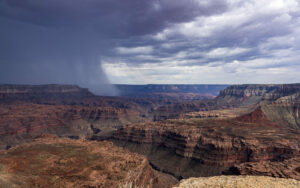Western Rivers Action Network Leaders –
Monsoon rain is finally here, but a few good storms won’t be enough to solve Arizona and the Colorado River Basin’s water challenges. Read on for a recap of the big news in Arizona water over the last couple of months.
Arizona is moving forward with a new commitment to implement the Drought Contingency Plan (DCP), a multi-state agreement which would leave more Colorado River water behind Hoover Dam and prop up Lake Mead levels to prevent catastrophic shortages. On June 28, United States Bureau of Reclamation Commissioner Brenda Burman brought the parties together to discuss the poor hydrology of the Colorado River Basin and to reactivate stalled talks on the subject. A steering committee process to work out an intra-Arizona deal to make these cuts palatable to Central Arizona Project water users begins July 26. The goal of the steering committee is to work out compromises between parties, and for the Arizona Department of Water Resources Director to be granted authority to sign onto the Drought Contingency Plan in early 2019 when the next legislative session begins.
Audubon’s work on water is for all of us – taking care of birds and the environment is taking care of people and their water. And the converse is true too: taking care of people and their water supply is taking care of the birds and the environment. Below are some key talking points to keep in mind, and share with your networks as the state moves forward with a plan to reduce our risk of water shortages.
Talking Points:
- This summer, the Bureau of Reclamation issued predictions that there is a 52 percent chance of shortage conditions at Lake Mead beginning in 2020, with a greater than 60 percent likelihood of shortage thereafter. Those are numbers that should give every Arizonan pause – it risks our economic and environmental livelihood.
- Arizona relies on the Colorado River for about 40 percent of our water supply, but demand for water from the Colorado River far exceeds supply. We need to live within our means and only use as much water as the Colorado River can supply us with.
- Nearly 90 percent of Arizona residents think low water supplies are a serious problem, and they have expressed overwhelming support for bold actions from the state to ensure the sustainable use of our water resources.
- It’s imperative that we plan for the long-term, and best way of doing that is to take urgent action to finish developing — and begin implementing — a Lower Basin Drought Contingency Plan.
-
- Monday, July 30th: Sierra Vista Police Department, 811 N. Coronado Drive, Sierra Vista, AZ (meeting attendees should use the lobby entrance)
- Wednesday, August 8th: Benson Fire Department Station 71, 375 E. 7th Street, Benson, AZ
- Wednesday, August 22nd: Sierra Vista Police Department, 811 N. Coronado Drive, Sierra Vista, AZ (meeting attendees should use the lobby entrance)
- Thursday, August 23rd: Pima Community College, 401 N. Bonita Avenue, Tucson, AZ




